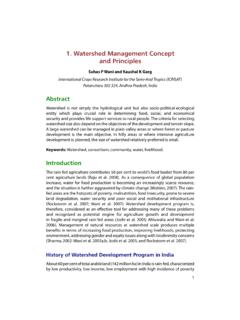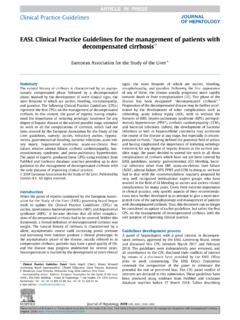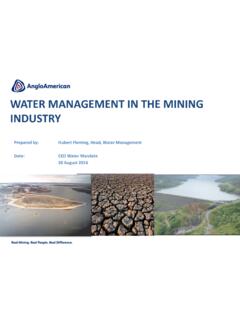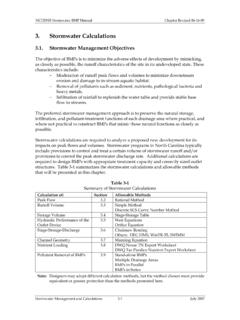Transcription of Disaster management: Floods, Earthquake, Cyclones and ...
1 Disaster management : Floods, Earthquake, Cyclones and Landslides A Disaster ( Fr. desastre=bad star) refers to sudden serious disruption of normal functioning of a society, involving large damages to life, property and environment, beyond its ability to cope with its own resources. It can be natural or man-made A natural Disaster is a natural process or phenomenon that may cause loss of life, injury or other health impacts, property damage, loss of livelihoods and services, social and economic disruption, or environmental damage. agricultural diseases & pests, damaging winds, drought and water shortage, earthquakes, emergency diseases (pandemic influenza), extreme heat, floods and flash floods, hail, hurricanes and tropical storms, landslides & debris flow, thunderstorms and lighting, tornadoes, tsunamis, wildfire etc.
2 Man-made Disaster : Human-instigated disasters are the consequence of technological hazards hazardous materials, power service disruption & blackout, nuclear blast, radiological emergencies, chemical threat and biological weapons, cyber-attacks, war etc. Some disasters can result from combination of both Natural and Man-made causes. These are called as complex emergencies. Disaster management refers to managing Disaster response in the country (Table ). India has been traditionally vulnerable to the natural disasters on the account of its unique geo-climatic conditions. About 60% of the landmass is prone to earthquakes of various intensities; over 40 million hectares is prone to floods; about 8% of the total area is prone to Cyclones and 69% of the area is susceptible to drought. Table: The four phases of Disaster management Mitigation: Preventing future emergencies or minimizing their effects Includes any activities that can prevent or reduce the chance of occurrence of an emergency, or reduce the damaging effects of unavoidable emergencies.
3 Mitigation activities take place before and after emergencies. This can be done by revised zoning, land use management , etc. Preparedness: Preparing to handle an emergency Includes plans or preparations for Disaster and to help response and rescue operations. Evacuation plans and stocking food and water are both examples of preparedness. Preparedness activities take place before an emergency occurs. Response: Responding safely to an emergency Includes actions which are to be taken to save lives and prevent further property damage. Response is putting your preparedness plans into action. Seeking shelter from a tornado or turning off gas valves in an earthquake are both response activities. Response activities take place during an emergency. Recovery Recovering from an emergency Includes actions need to be taken to return to a normal or an even safer situation following an emergency and one should also consider things which would mitigate the effects of future disasters.
4 Recovery includes getting financial assistance to help pay for the repairs. Recovery activities take place after a Disaster . National Disaster management Authority (NDMA) is an agency of the Ministry of Home Affairs and is responsible for framing policies, laying down guidelines and coordinating with the State Disaster management Authorities (SDMAs) to ensure a holistic and distributed approach to Disaster management . NDMA was established through the Disaster management Act enacted by the Government of India in May 30, 2005. The Prime Minister is the ex-officio chairperson of it. FLOODS Floods occur when land that is usually dry is submerged by large amounts of water. Sudden submergence or inundation of land area with water is called as flood.
5 The occurrence of floods can be due to both natural and human causes. 1. Anthropogenic causes of floods include: Clearing of forests: Lack of vegetation cover to hold the soil together on slopes causes erosion and deposition in river beds making them shallow, flooding occurs when these rivers overflow. Also bare slopes increase surface runoff and volume of water flowing into the rivers. 2. Urban development: The clearing of land for development of residential, commercial and industrial complexes have rapidly increased built-up areas. These concrete pavements and roads prevent infiltration of rainwater into the ground coupled with lack of vegetation cover to intercept the rain water results in increased runoff flowing into the rivers resulting in flooding. 3. Improper farming and other land use practices: The combination of absence of forest cover on one hand, and inappropriate farming and land-use practices on the other have aggravated the flood devastation.
6 There are hardly any forests left in the catchment area of the rivers. It is well known fact that the forest areas are characterized by high infiltration capacity. 4. Enhanced Green house effect: Various human activities resulting in increased green house effect and causing global warming are leading to various climate changes such as higher rainfall in short duration, melting of more ice etc. All these have lead to increased incidences of floods. Natural causes of floods: 1. Excessive rainfall: Floods occur when rainwater is unable to seep into the ground quickly enough or rivers overflow their banks because river channels cannot contain excess water. It is common in tropical areas. 2. Storm Surges: It occurs when strong winds raise the waves in the ocean to exceptionally high levels, causing them to crash into the coast and flood the land. It is common in coastal areas with low-lying relief.
7 3. Melting Snow: Melting of snow in spring releases large amount of water into the rivers, causing them to overflow their banks. It is common in places with cool temperate climate. 4. Global Atmospheric processes: Abnormal weather phenomenon such as El Nino (warming of surface ocean waters at Southeastern part of Pacific Ocean). 5. Earthquakes: Earthquakes can bring about landslides or trigger tsunamis. When landslides occur, loosened soil, rocks, mud debris etc. may be deposited in rivers causing overflowing of these rivers. Tsunamis triggered by strong undersea earthquakes can flood and devastate coastal settlements. Impact of floods: 1. Loss of life: Floods mostly strike people unprepared, leading to loss of lives in drowning. Along with livestock and other life forms. Impact is higher in flood plain areas which are densly populated, 2. Damage to infrastructure and property: Flood cause huge losses to homes, roads, power supply and other infrastructure.
8 3. Spread of Diseases: After flood water recedes, shallow stagnant water may cover areas over a considerable period of times. This may result in outbreak of water borne diseases. Moreover homeless flood victims are housed in temporary shelters which are mostly overcrowded and with poor sanitation conditions which may turn situation worse. 4. Loss of natural habitat: Trees, vegetation and other natural habitats may get destroyed leading to loss of biodiversity. Mitigation of floods Floods can be mitigated by structural, water control and non-structural measures such as: Structural methods include building dams, reservoirs, and retarding basins, channel management and embankments. Water control methods: include increasing forest and vegetation cover, watershed management , flood proofing and catchment modifications. Schemes of drainage and flood protection, Non-structural methods: flood forecasting, flood warning and emergency preparedness systems, flood insurance, public information and education, and flood relief Earthquake An earthquake (also known as a quake, tremor or temblor) is the shaking of the surface of the Earth, with sudden release of energy in the form of seismic waves on the surface of the earth.
9 The point inside the crust where the pressure is released is called the focus. The point on the Earth's surface above the focus is called the epicentre. When earthquake occurs beneath the sea it causes tsunami. The study of earthquakes is called as seismology and the instrument used to measure seismic waves is called as seismometer or seismograph. The magnitude of earthquake is measured by richter scale and intensity by mercalli scale( Table). Table: Effects on earthquake with various magntitudes. Magnitude Description Mercalli intensity Average earthquake effects Micro I Microearthquakes, not felt, or felt rarely. Minor I to II Felt slightly by some people. No damage to buildings. III to IV Often felt by people, but very rarely causes damage. Light IV to VI Noticeable shaking of indoor objects and rattling noises. Felt by most people in the affected area.
10 Generally causes none to minimal damage. Moderate VI to VII Can cause damage to poorly constructed buildings. None to slight damage to all other buildings. Felt by everyone. Strong VIII to X Destructive. Earthquake-resistant structures survive with slight to moderate damage. Poorly designed structures receive moderate to severe damage. Major X Causes damage to most buildings, some partially or completely collapse or receive severe damage. Great Major damage, structures likely to be destroyed. Damage earthquake-resistant buildings. Felt in extremely large regions. and greater At or near total destruction severe damage or collapse to all buildings. Permanent changes in ground topography. Souce: Geological Survey documents Causes of earthquake: According to the theory of plate tectonics, Earth is composed of many individual plates that move and interact, constantly changing and reshaping Earth's outer layer.







